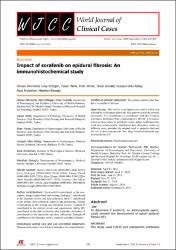| dc.contributor.author | Tanrıverdi, Osman | |
| dc.contributor.author | Erdoğan, Uzay | |
| dc.contributor.author | Tanık, Canan | |
| dc.contributor.author | Yılmaz, İlhan | |
| dc.contributor.author | Günaldı, Ömür | |
| dc.contributor.author | Adilay, Hüseyin Utku | |
| dc.contributor.author | Arslanhan, Ayça | |
| dc.contributor.author | Eseoğlu, Metehan | |
| dc.date.accessioned | 2019-06-18T07:41:58Z | |
| dc.date.available | 2019-06-18T07:41:58Z | |
| dc.date.issued | 2018 | en_US |
| dc.identifier.uri | https://10.12998/wjcc.v6.i9.249 | |
| dc.identifier.uri | https://hdl.handle.net/20.500.12462/5468 | |
| dc.description | Adilay, Hüseyin Utku (Balikesir Author) | en_US |
| dc.description.abstract | AIM To determine if sorafenib, an antineoplastic agent, could prevent the development of spinal epidural fibrosis (EF). METHODS The study used CD105 and osteopontin antibodies in an immunohistochemical approach to quantify EF that occurred as a consequence of laminectomy in rats. Wistar albino rats (n = 16) were divided into two groups: control (L1-2 level laminectomy only) and sorafenib treatment (L1-2 level laminectomy + topical sorafenib). The animals were euthanatized after 6 wk, and the EF tissues were examined for histopathological changes after immunohistochemical staining. The EF grades were assigned to the tissues, and the treatment and control groups were compared. RESULTS The EF thickness, inflammatory cell density, and arachnoid adherences determined by light microscopy were significantly higher in the control group compared to the sorafenib-treated group. Based on fibrosis scores, the extent of EF in the treatment group was significantly lower than in the controls. Immunohistochemical staining for CD105 to identify microvessels revealed that the EF grades based on vessel count were significantly lower in the treatment group. Staining for osteopontin did not show any significant differences between the groups in terms of the extent of EF. The staging of EF based on vascular counts observed after immunohistochemical staining for CD105, but not for osteopontin, was compatible with conventional staging methods. Neither toxic effects on tissues nor systemic side effects were observed with the use of sorafenib. CONCLUSION Local administration of sorafenib significantly reduced post-laminectomy EF. Decreased neovascularization in spinal tissue may be due to the sorafenib-induced inhibition of vascular endothelial growth factor. | en_US |
| dc.language.iso | eng | en_US |
| dc.publisher | Baishideng Publishing Group Inc. | en_US |
| dc.relation.isversionof | 10.12998/wjcc.v6.i9.249 | en_US |
| dc.rights | info:eu-repo/semantics/openAccess | en_US |
| dc.subject | Vascular Endothelial Growth Factor | en_US |
| dc.subject | CD105 | en_US |
| dc.subject | Osteopontin | en_US |
| dc.subject | Sorafenib | en_US |
| dc.subject | Spinal Epidural Fibrosis | en_US |
| dc.title | Impact of sorafenib on epidural fibrosis: An immunohistochemical study | en_US |
| dc.type | article | en_US |
| dc.relation.journal | World Journal of Clinical Cases | en_US |
| dc.contributor.department | Tıp Fakültesi | en_US |
| dc.identifier.volume | 6 | en_US |
| dc.identifier.issue | 9 | en_US |
| dc.identifier.startpage | 249 | en_US |
| dc.identifier.endpage | 258 | en_US |
| dc.relation.publicationcategory | Makale - Uluslararası Hakemli Dergi - Kurum Öğretim Elemanı | en_US |


















